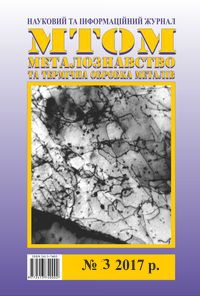Influence of available impact energy of the testing macnine on drop weight tear test characteristics of high toughness pipeline steels
Keywords:
, drop weight tear test, available impact energy of the testing machine, shear fraction quantity, absorved energy, metal hardening, high toughnessAbstract
Problem statement. The methodological questions connected to Drop Weight Tear Test (DWTT) of high toughness plates and pipes of high pressure gas pipelines are considered in this article. The imperfection of operating standards regarding to the choice of the values of available impact energy providing correct carrying out tests of any size of steel is marked. Purpose. Appraisal of influence of the available impact energy on the results of DWTT on indicators of shear fraction quantity and the absorbed energy of destruction the full-thickness samples high-toughness pipe steels from among the most widely applied in modern construction of gas pipelines of high pressure. Material and methodology. Plates and basic metal of pipes grade X65, X70 and X80 different thickness were researched. DWTT were carried out on Zwick test machines of various capacities. Results. Boundaries of application of recommendations of the APIRP5L3 and the EN10274 standards at the choice of available energy value of impact testing machine to DWTT of pipe steels with thickness 25 mm and less. Scientific novelty. In this article was estimated influence of the available impact energy on the results of DWTT of high toughness pipe steels. Practical value. Recommendations about the choice available impact energy on results of DWTT will increase of test exactness and reliability of resistance appraisal of gas pipelines to destruction.
References
Halsen K.O. Drop Weight Tear Testing of High Toughness Pipeline Material / K.O. Halsen, D.N. Veritas // Proc. of IPC 2004 Int. − Pipeline Conference (October 4−8, 2004). − Calgary, Alberta, Canada, 2004. − Pp. 87−96.
Hwang B. Analysis of Inverse Fracture Occurring in Hammer-Impacted Region During Drop-Weight Tear Test of a High-Toughness Linepipe Steel / B. Hwang, S. Lee, Y.M. Kim, N.I. Kim // Proceedings of the thirteenth Int. − Offshore and Polar Engineering Conference (May 25−30, 2003). − Honolulu, Hawaii, USA, 2003.
Wilkowski G. Evaluation of Fracture Speed on Ductile Fracture Resistance / G. Wilkowski, D.J. Shim, F.W. Brust, D. Rudland, D. Duan // Pipeline Technology Conference (October 12-14, 2009). − Ostende, Belgium, 2009.
Junker G. Einflesse von Prefparametern auf die Ergebnisse von BDWT−Versuchen / G. Junker // Mannesmann, 8. − Grobron Symposium in Dyusseldorf (10.02.1985−17.02.1985).
API 5L3−96 (2003). Трубы магистральные. Рекомендованный метод испытания на ударный разрыв падающим грузом труб для магистральных трубопроводов.
BS EN 10274:1999. Материалы с металлическими свойствами. Испытания падающим грузом.
ГОСТ 30456−97. Металлопродукция. Прокат листовой и трубы стальные. Методы испытания на ударный изгиб.
Erdelen-Peppler M. Significance of Dwt Testing for Linepipe Safety / M. Erdelen-Peppler, R. Gehrmann, G. Junker, A. Liessem // 6th International Pipeline Conference IPC 2006 (September ). − Calgary, Canada, 2006.
Wilkowski G. Fracture Propagation Toughness Measurements / G. Wilkowski // Paper K. − 6th Symposium on line Pipe research. − American Gas Association, Arlington. − VA Catalogue № L30175. − 1979.
Демофонти Дж. Оценка остановки распространения разрушения в стальных трубах Х100, полученных по технологии ТМКО, для газопроводов высокого давления / Дж. Демофонти, Дж. Маннуччи, М. Ди Бьяджо, А. Фонзо // Современные стали для газонефтепроводных труб. Проблемы и перспективы. – Москва, 2006. − С. 22−31.
Higuchi R. New Concept and Test Method on Running Ductile Fracture Arrest for High Pressure Gas Pipeline / R. Higuchi, H. Makino, I. Takeuchi.
Пемов И. Ф. Соотношение работы разрушения и количества вязкой составляющей в изломе образцов при ИПГ толстолистового проката, полученного контролируемой прокаткой / И. Ф. Пемов, Ю. Д. Морозов и др. − Металлург. − № 1. − 2012. − С. 63−68.
Downloads
Published
Issue
Section
License
Authors that are published in this journal agree to follow the conditions:
Authors reserve the right to the authorship of his work and cede the right to the journal of first publication of this work on conditions of the license under the Creative Commons Attribution License, which allows others to distribute it freely with the obligatory reference to the author of the original work and the first publication of the work in this journal.

